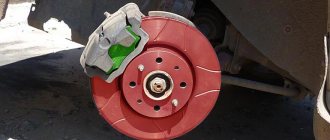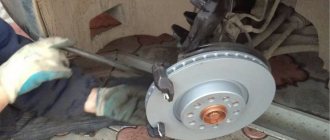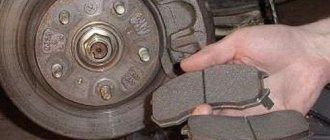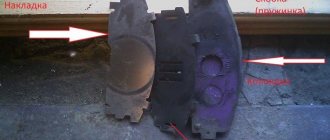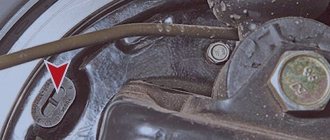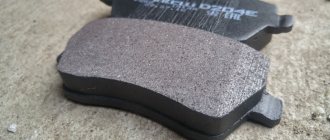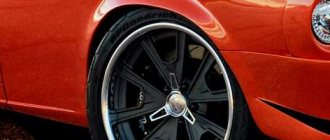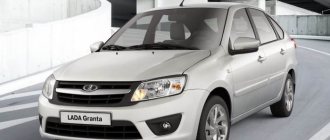If you press the brake pedal hard, and your Lada Kalina (VAZ 1118) stops slowly, or when you press the brake you hear an extraneous sound, it means that the front brake pads on Kalina need to be replaced.
Worn pads and brake discs are indicated by pounding of the brake pedal during heavy braking. Another sign of pad wear is the presence of a red coating on the brake discs from metal dust from the brake mechanisms. You can learn more about methods for diagnosing brake pads in the article “When to change front brake pads?”
On average, it is believed that replacing brake pads on Kalina is necessary every 40,000 kilometers of the car, taking into account the driving style. But this value is approximate, since there are a number of factors that can significantly shorten this period. So how to change brake pads on a Lada Kalina with your own hands?
Before starting repairs, place the car on a flat surface and place wheel chocks or bricks under the front and rear wheels.
Pay attention to the hydraulic brake reservoir - if it is on about, then you need to pump out some of the fluid with a rubber bulb or syringe. This is necessary to ensure that fluid does not flow out of the reservoir when the piston is inserted into the working cylinder of the brake mechanism.
Take the wheel wrench and remove the wheel bolts. There is no need to unscrew them completely. Raise one side of the car with a jack. After this, unscrew the wheel mounting bolts completely and remove it.
It is better to place the removed wheel under the car, especially on the road. In this case, if the jack breaks, the car will fall on the wheel. Otherwise, the car will fall on the brake disc, which can be seriously damaged.
To make it easier to replace the pads, turn the steering wheel all the way in the direction you will be working. Bend back the locking washers with pliers or hammer to loosen them.
Take keys No. 13 and No. 17 and unscrew the caliper guide.
Move the brake cylinder piston inward. At the same time, make sure that the piston moves smoothly, without jamming or wedging. If the piston does not move when you apply force, the caliper will most likely need to be repaired or replaced.
Then completely remove the two guide bolts. Lift the caliper and compress the brake pad piston.
Carefully inspect all brake mechanisms.
- The brake cylinder and piston guide boots must not be torn or swollen.
- The brake hose must not contain any traces of cuts or cracks up to the reinforcement layer. In addition, the brake hose should not have any leaks or fogging.
- The brake disc must be worn evenly, and its thickness must not be less than the permissible value determined by the manufacturer
If any of the mechanisms has the above defects, it should be replaced.
Remove the brake pads. Clean the guides on which the pads fit from scale and rust. If you don't do this, you simply won't be able to put on the new pads. It’s better to do this with a brush, but if you don’t have one at hand, you can use a screwdriver.
Before installing new brake pads, try to recess the piston into the cylinder as deeply as possible. After which you can install new pads.
Check that the ferro-braking element of the pads is in contact with the brake disc. Insert the upper guide into place, slide the brake cylinder into the lower guide and tighten it.
Turn the brake disc - it should rotate freely. If the disc jams, then most likely the reason is that you did not clean the pad guides well enough. The reason could also be the factory paint on the pads themselves. In this case, it must be cleaned with a file. Tighten the locking nuts back.
We recommend: Why do car headlights sweat from the inside and what to do about it?
Level the steering wheel. Replace the wheel and tighten the bolts. The bolts should be tightened crosswise. Lower the jack almost all the way so that the wheel is on the ground, and tighten the wheel bolts. Now lower the jack completely.
Use the same procedure to replace the pads on the other wheel.
After replacing the pads, be sure to return to the car and press the brake pedal several times. You need to ensure that the pedal stops falling. Check the brake fluid level in the reservoir under the hood. If the pedal continues to fall, you should look for a brake fluid leak.
Step-by-step instruction
Repairs are best done in a pit or on a lifting mechanism . This will be the most convenient way to work. As a last resort, you can use a jack, but the car must be installed on the handbrake and additionally secured with wheel stands.
Tools
- key to 7;
- flat screwdriver;
- hammer;
- pliers;
- knob with 30mm head;
- mounting blades.
Description of procedures with photos
To gain access to the disk, jack up the car and remove the wheel.
- Unscrew the guide pins.
Use a wrench to unscrew the spacers on the brake disc.
- We knock the drum off the hub using a hammer with a wooden backing.
Tap the disc with a hammer to remove it from the hub
- Using a flat-head screwdriver, remove the upper and lower springs from their engagement.
Use a screwdriver to pry the hook of the spring and disengage it.
- Remove the clamping mechanism and pull out the block.
After removing the clamping mechanism, the brake pad can be easily removed
- Remove the spacer bar.
We take out the spacer bar
- To dismantle the second part, disconnect the pressure spring and disengage the lever.
Pull the spring towards you and remove the lever from engagement
- We take out the cotter pin with pliers and remove the washer.
Using pliers, pull out the brake pad cotter pin.
- We pull out the “finger”.
Remove the rear brake pad pin
Before installing new parts, the brake disc must be thoroughly wiped. Assembly is carried out in reverse order. To tighten the springs, use a regular screwdriver. Make sure the hooks on the edges are fully seated in the holes.
Tip: After completing the repair, press the brake pedal several times so that the pads come close to the disc.
see also
Brakes jerkily
- 72 0 83k
Lada Kalina cars of both generations have front disc brakes and rear drum brakes. As original front brake pads for Kalina 1, the catalogs indicate 21100-3501080-00 and 21100-3501080-01, for Lada Kalina 2 the article number is 11180-3501080-00. The same catalog numbers are used for Lada Priora.
Factory brake pads TIIR
Rear drum brake pads are specified as 21080-3502090-01 or 11180-3502090-10 (with ABS) for Kalina 1 and 2.
Many of these part numbers are invalid; instead, online parts stores offer other original part numbers or equivalents. This makes sense, since in the case of the Lada Kalina (and LADA in general), the original is often inferior in quality to its substitutes.
| Front disc brake pads Lada Kalina | ||
| With dimensions - length: 104.4 mm; width: 62.1 mm; thickness: 17. mm. | ||
| Manufacturer | Catalog number | *Price, rub.) |
| Brembo | P41003 | 780 |
| ** Ate | 13046029652 | 703 |
| Ferodo (Premier) | FDB527 | 640 |
| Hankook Frixa | FPE103 | 626 |
| NiBK | PN0223 | 536 |
| TRW | GDB469M | 495 |
| Ferodo (Target) | TAR527B | 405 |
| Lada | 21083501080 | 380 |
| Finwhale | V218 | 363 |
| Allied Nippon | ADB0173 | 330 |
The most popular brake pad analogues are Ate, Brembo, TRW, TSN, Finwhale and Ferodo. The latter are divided into two types according to the color of the box - “red” and “green”. “Green” ones, with the prefix Target in the name, are positioned by the manufacturer as an improved replacement for factory pads, but they are not intended for heavy loads. Red, with the prefix Premier, are considered premium pads that can withstand extreme loads.
The best-selling disc brake pads for Lada Kalina are products from Ate, followed by TRW. Drum brake pads for Kalina are most often purchased from TSN due to its favorable price. They are slightly inferior in popularity to TRW and Ate pads.
| Rear drum brake pads Lada Kalina | ||
| With dimensions - diameter: 200 mm; width: 41 mm. | ||
| Manufacturer | Catalog number | Price, rub.) |
| Ferodo | FSB240 | 860 |
| Ate | 03013702312 | 815 |
| Sangsin | SA183 | 715 |
| TRW | GS8210 | 672 |
| Finwhale | VR318 | 658 |
| Bosch | 0986487813 | 610 |
| Profit | 50010240 | 650 |
| Allied Nippon | ABS1701 | 612 |
| Trialli | GF231 | 547 |
| TSN | 232 | 460 |
According to the rating of brake pads for Lada Kalina on PartReview dated 04/02/20, owners prefer TIIR products. Manufacturers TRW, Trialli and Ferodo also stand out.
The brake pads indicated here are also suitable for other VAZ cars: 2110, 2114, Lada Granta and others, with R13 and R14 brake discs.
Front brake pads are replaced approximately twice as often as rear brake pads. The exact frequency of replacement is quite difficult to establish, but the front pads are changed at intervals of 30-50 thousand km, and the rear pads at intervals of 60-90 thousand. To more accurately determine when Lada Kalina brake pads need to be replaced, it is worth checking the thickness of the friction linings every 15,000 km. A thickness of about 2 mm is considered critical.
Drivers are often motivated to change brake pads on Kalina by squeaking brake pads. Special plates installed on the disc brake pads from the outside help significantly combat this. They are called anti-squeak plates. Such plates can often be found in more expensive brake pad sets. However, you should choose brake pads not based on the presence or absence of anti-squeak plates, but on the basis of reliability and braking efficiency.
*The price of Lada Kalina brake pads is given as of April 2017 for Moscow and the region. **Bold indicates those pads that are most popular in a particular case.
Front brake pad replacement process
Replacing front brake pads is a standard and not complicated operation on almost all cars. On the Lada Kalina, as on other cars of the VAZ series, this process takes 30-40 minutes and can be done with one pair of hands.
So, to replace the front brake pads of a Lada Kalina you will need the following tool:
- jack,
- pliers,
- wheel wrench,
- flat screwdriver,
- recoil guards,
- keys and heads.
Now that you have figured out the tools, you can get to work:
- We put the car on the parking brake, secure the wheels with wheel chocks and remove the front wheel. If possible, you can remove the second one.
- We turn the steering wheel in the direction we will work with.
- We bend the locking plate. In this case, pliers and a screwdriver will come to the rescue.
Everything is marked in the photo. We bend the locking plate using a flat screwdriver, unscrew the rest with keys 13 and 17
- Using the key “13” and “17” we unscrew the fixing bolt.
- We dismantle the caliper, or lift it up and hang it on the “wire”.
Raise the caliper using one bolt
- Recess the brake piston and remove the pads. You can use a balloon key.
We use a special device similar to a clamp
- To make installation and grinding easier, new pads can be lightly ground along the edges of the friction plate.
- Now, you can install new pads and put everything back together.
We install new pads. If you can’t put the caliper back on, it means you haven’t fully retracted the brake cylinder to its original position.
Thus, it is easy and simple to replace the front brake pads on the Lada Kalina.
Refinement of pads
To improve braking, you can install ProSport, Brembo or Vanx sports brake pads. But, to perform these manipulations, you will need to replace the brake drums and calipers, since the pads will not fit the standard sizes.
Read more about replacing rear brake pads on Lada Kalina here.
Brake pad set Lada SPORT
Also, if we are talking about modifications and tuning, it is worth installing soft pads that have 1 mm more friction surface. They perform better braking and wear out the brake disc less, but at the same time their service life is up to 15,000 km.
General Characteristics of Pad Problems
The most common problem with brake pads (see photo) is squeaking, and this sound can be produced even by a newly purchased car. This sound will continue for several days while the grinding process takes place. After this, the pads on the Lada Kalina car will work silently.
A layer of material can be erased much faster by braking sharply several times while driving. Therefore, accelerate the car to 90 km/h or more if you have a Lada Kalina Sport, and press the brake hard. The procedure must be repeated until the front or rear pads heat up to the required temperature and their excess parts burn out.
However, this does not happen all the time. If even after prolonged use they do not stop squeaking, you will have to replace them. Keep in mind that the brake does not always start to work poorly; in some cases it only causes negative sensations for the driver. You must immediately try to determine the cause of the sound.
Squeaking in the brakes can be caused by foreign moisture that gets inside when driving at high speeds, which happens quite often if you have a Lada Kalina Sport. In this case, clean the brakes and wait a few days before using the brakes again. In addition, the front and rear pads begin to squeak when the ambient temperature drops below zero.
Which ones to choose
Today in auto shops and at the car market you can find pads for Kalina from dozens of manufacturers, some of which are either uncertified products or even fakes made in the nearest gateway.
It is better to buy brake pads in specialized stores, requiring a quality certificate for the purchased product. As for the manufacturer, it is better to give preference to original spare parts.
Front VAZ brake pads for Lada Kalina have catalog number 2110-3501080, and cost between 320-400 rubles. A good alternative for them are analogues from foreign companies such as Pilenga, ABS, Bosch, Ferodo, Master-Sport, Hella, Delphi and others.
The original rear pads for Kalina are numbered 11180-3502090-55. Their cost is 500-650 rubles.
conclusions
When choosing rear brake pads for Lada Kalina, you should be quite careful, since there are now quite a lot of fakes on the automotive spare parts market, especially originals. Therefore, many Kalina owners have switched to using analog spare parts, which are much better in quality, but also higher in price. You can do the replacement yourself without any problems. Of course, there are times when the block does not reach the drum, but this is due to the development of the second one.
Drum-type brakes are installed on the rear axle of Kalina-2 vehicles. The rotation of the front wheels, in turn, is limited by disc-based mechanisms. In all trim levels except the “standard” one, the ABS system is used. Which imposes restrictions on the choice of rear brake pads: part 3502090-01 is suitable for the “Standard” configuration, and 3502090-10 for all others. The design of the front pads is identical in all trim levels.
Content
Replacement timing
In the Lada Kalina model, many car enthusiasts note that the brake pads are too hard. It is recommended that immediately after purchasing a new car, you replace factory parts with products from other manufacturers . Such pads will not scratch the brake disc and will ensure reliable operation of the entire system. During operation, it is also necessary to periodically inspect parts. If the thickness of the rear pad is below 2 mm, it needs to be changed.
On average, parts of normal quality last for 2 years or 10-12 thousand kilometers. But with frequent movement in the city, they wear out faster. It is best to check the condition of these parts before and after the winter months, as well as if squeaking occurs during braking.
In conclusion, about the important
Replacing the pads on LADA Kalina should only be done as a complete set. This action allows you to avoid incorrect redistribution of braking forces between wheel units, otherwise the car may drift off the trajectory. Immediately after the replacement procedure, the pads will not be sufficiently effective, because they require some time to optimally grind into the disc surface. Also, at first (about 200 km), avoid sharp braking so as not to cause scuffing in the working area of the disk.
Now we are convinced that replacing the pads in the Lada Kalina is very easy. Even an inexperienced owner who will need the tool we have indicated can dare to do this.
We do not recommend skimping on safety and purchasing brake pads for LADA Kalina of dubious origin. Trust only proven brands.
Selection of pads and part numbers
Every Kalina car owner faces a difficult choice of spare part. What is better, original or analogue? After all, pads are the first link in traffic and braking safety. The answer lies on the surface. Both of them are quite good in quality and effect. But modern analogues are becoming even better, since the friction material of the majority is much better and more durable.
So, let's look at what front pads are suitable for the Lada Kalina.
Original pads
Let's start with the original part from AVTOVAZ. The catalog number of the part by which the search is performed looks like this - 2110-3501080. These are the same pads that are installed on the VAZ 2110 and Priora. The factory decided not to change the structure of the front brakes. Their cost is 400 rubles per set.
Analogs
Red Ferodos brake better, but it is believed that they eat up the brake disc a lot
Now, let's look at possible analogues that can be installed instead of the original brake pads on the Lada Kalina.
A table of analogues, as well as their catalog numbers and prices.
| Manufacturer's name | vendor code | Average price in the Russian Federation in rubles |
| Dafmi | D140IE | 390-450 |
| Master-Sport | 13-046D-2965-2-E-SET/4/-MS | 590-630 |
| Tomex | 10-361 | 600 |
| Mapco | 6502 | 620 |
| Pilenga | FD-P2003 | 850 |
| Trialli | PF965 | 850 |
| Fenox | BP40006O7 | 865 |
| Finwhale | V210 | 910 |
| Hola | BD811 | 950 |
| Optimal | 12075 | 978 |
| ABS | 37079 | 1070 |
| EGT | 322107EGT | 1150 |
| Denckermann | B111048 | 1165 |
| LRP | 05P988 | 1165 |
| Samko | 5SP988 | 1185 |
| LINXauto | BD-4601 | 1200 |
| FiT | FP0289 | 1320 |
| TRW | GDB1446 | 1350 |
| Road House | 2221.02 | 1350 |
| Icer | 181308 | 1360 |
| Brembo | P41003 | 1700 |
| Delphi | LP551 | 1765 |
| Girling | 6114461 | 2400 |
| Feredo "Premium" | FDB1325 | 3000 |
As you can see from the table, the choice of front brake pads for the Lada Kalina is quite wide and the owner will have plenty to choose from. Of course, the pricing policy for many analogues is too high, since compared to the originals at 400 rubles and the analogue at 2000 rubles. many people choose the original.
Non-original pads for Kalina, Nippon brand, very popular among Kalinovods
But, if you take Brembo, then the quality and service life of the pads are 2-3 times better, and the level of braking is 50% higher! (according to the results of independent tests). At the same time, they wear out 3-4 times slower, since they are made from higher quality material.
After replacing the brake pads, do not rush to leave. First, check the operation of the brake system. To do this, start the engine and press the brake pedal several times. After replacing the pads, especially if the brake fluid was taken from the reservoir, it is possible that the pedal will fail several times, but after that it should work normally.
Press the pedal 3-4 times, and if you feel that there is some resistance when pressing it, you can go out and check the results of your work. Please note that with new pads the braking will be sharper, so you will have to get used to the pedal.
When to change the rear pads of LADA “Kalina”
The peculiarity of the LADA Kalina braking system is that when braking, the load is distributed unevenly and most of the kinetic energy is absorbed by the front brakes. Therefore, replacing the rear Kalina pads is done 2-3 times less often than the front ones. To find out when it’s time to change the pads, it’s useless to rely on the Kalina’s odometer readings. The number of kilometers a car travels between pad replacements can vary by half. The rate of their wear is influenced by many factors, some of which cannot be controlled and taken into account:
- driving style (during aggressive driving with frequent sharp acceleration and braking, the pads can wear out several times faster than during calm, smooth driving);
- exposure to external factors (chemicals that are sprinkled on the road surface in winter, other active substances that get on the friction linings).
Under normal conditions, the Kalina rear pads are replaced after 50-60 thousand kilometers. But you need to focus not on mileage, but on the thickness of the friction linings. If they are chipped, peeling, or become thinner than one and a half millimeters, they must be immediately replaced with new ones. Otherwise, damage to the brake drum or leakage of brake fluid may occur (if the linings are thin, the pistons may completely come out of the brake cylinders, which will cause depressurization of the circuit).
